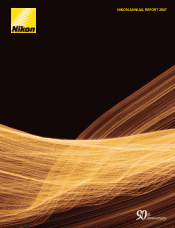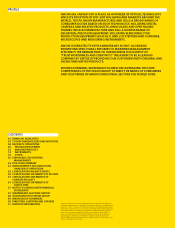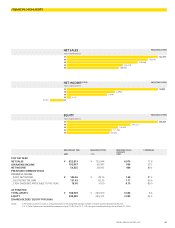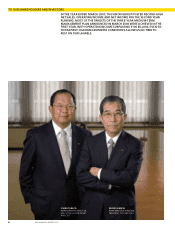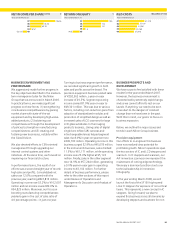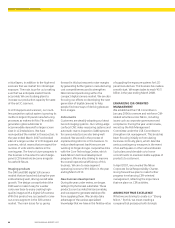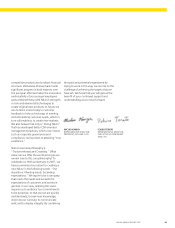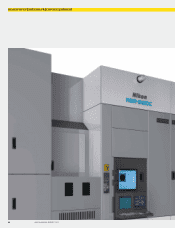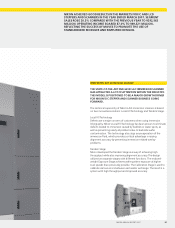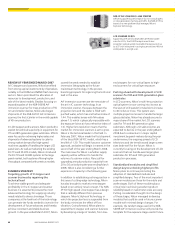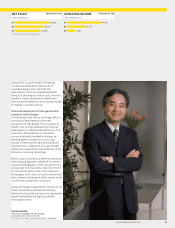Nikon 2007 Annual Report Download - page 10
Download and view the complete annual report
Please find page 10 of the 2007 Nikon annual report below. You can navigate through the pages in the report by either clicking on the pages listed below, or by using the keyword search tool below to find specific information within the annual report.
NIKON ANNUAL REPORT 200708
REVIEW OF YEAR ENDED MARCH 2007
In IC steppers and scanners, Nikon benefited
from strong capital investment by chipmakers,
notably in the DRAM and NAND flash memory
sectors. Nikon prioritized the allocation of
resources to development, production, and
sale of the latest models. Besides focusing on
expanding sales of the NSR-S609B ArF
immersion scanner for mass production of 55
nm and smaller devices, Nikon also began
shipments of the NSR-S610C ArF immersion
scanner, the first scanner in the world capable
of 45 nm production.
In LCD steppers and scanners, Nikon worked to
exploit its technical superiority in equipment for
7th and 8th generation glass substrates. Efforts
were focused on achieving higher sales and
shipments of advanced systems to cater to
strong market demand for high-speed
machines capable of handling the larger LCD
panel sizes. As well as marketing the existing
FX-71S and FX-81S models, Nikon introduced
the FX-73S and FX-83S systems to the large
panel market, both systems offering higher
throughput compared with previous models.
BUSINESS STRATEGY
Targeting growth of IC stepper and
scanner business by regaining the
technical lead
To achieve stable growth and adequate
profitability in the IC stepper and scanner
business it is essential to possess the most
advanced technology for supplying industry
needs related to device shrinkage. Those
companies at the forefront of the technology
can generate the funds needed to invest in the
development of future advances and thereby
achieve consistent and stable business
growth. In the year ended March 2007, Nikon
sowed the seeds needed to establish
immersion lithography as the future
mainstream technology, in the process
boosting prospects for regaining the technical
lead in this area.
ArF immersion scanners are the new state of
the art in IC scanner technology. In an
immersion scanner, the space between the
projection lens and the wafer is filled with
purified water, which has a refractive index of
1.44. This enables lenses with NA values
above 1.0, which is physically impossible with
dry exposure (since air has a refractive index of
1.0). Higher lens resolution means that the
market for immersion scanners is set to grow.
Nikon is the technical leader in this field. In
February 2007, Nikon made the first shipment
of the latest NSR-S610C model, which has a
lens NA of 1.30. This model has won customer
approval, and sales will begin in earnest in the
second half of the year ending March 2008.
The main issue for Nikon is whether supply
capacity will be sufficient to handle the
volume of customer orders. Plans call for
upgrading annual production capacity from
20 to 30 units during the year ending March
2008. Nikon is also considering a further
expansion of capacity in the following year.
In addition to establishing a strong position in
this area of cutting-edge technology, Nikon
has also brought to market a new stepper
based on an entirely novel concept. The NSR-
SF150 high-speed i-line stepper has a design
that is radically different from previous
steppers. Nikon’s Skyhook Technology, in
which the projection lens is suspended from
the body, minimizes the effect of floor
vibration. Going forward, Nikon plans to
expand the IC stepper and scanner business
by developing a range of models, from low-
end steppers for non-critical layers to high-
end scanners for critical layer exposure.
Pushing ahead with development of LCD
scanners for 9th and 10th generation glass
substrates
In LCD scanners, Nikon’s multi-lens projection
optical system is now coming into its own as
the sizes of LCD panels for televisions increase
to 40 inches or more. This system uses
multiple projection lenses to handle the larger
glass substrates. Nikon has already secured a
major share of the market for LCD scanners
used for 7th and 8th generation glass
substrates. Although unit sales volumes are
expected to decline in the year ending March
2008 due to a downturn in major capital
investment by panel-makers during the year
under review, the ongoing spread of LCD
televisions and the trend toward larger screen
sizes bode well for the future. Nikon is
currently focusing on the development of LCD
scanners that can handle even larger glass
substrates for 9th and 10th generation
production processes.
Standardized modules and simplified
design key to unlocking higher profits
Nikon plans to continue promoting the
adoption of standardized modules and
simplified designs. Two of the most important
scanner modules are those for the reticle and
wafer stages. Both of these modules play a
critical role in achieving excellent product
reliability based on nanometer-scale accuracy.
Putting considerable thought into the design
of these stages, Nikon managed to develop
modules that could be used in future scanner
models with minimal design changes. For
example, the tandem stage used in the NSR-
S609B ArF immersion scanner will provide the
template for the exposure stage used in future
PRECISION EQUIPMENT
NSR-SF150 SCAN FIELD i-LINE STEPPER
Delivering powerful performance for non-critical layers
in next-generation memory and MPU, the NSR-SF150 is
based on a new platform that leverages Nikon’s
Skyhook Technology.
LCD SCANNER FX-83S
Supporting the world’s largest 8th generation plate
sizes for LCDs, the FX-83S adopts a multi-lens
projection optical system to enable the exposure of up
to a 57-inch wide panel in a single scan and two 48-inch
wide panels in a single scan.

